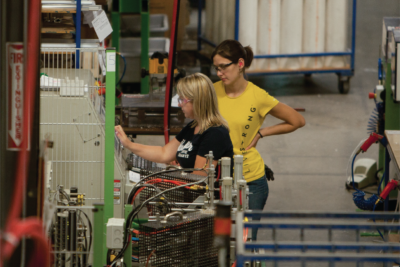 Last fall, I wrote about the growing field of employee ownership (EO): what it is, the forms it can take, and how it can benefit workers. I also shared some examples of EO companies that are connected to the National Fund network. Now, I’d like to take a deeper dive into this topic. How can workforce development practitioners support employee ownership? And how can employee-owned firms and advocates engage more meaningfully with workforce developers?
Last fall, I wrote about the growing field of employee ownership (EO): what it is, the forms it can take, and how it can benefit workers. I also shared some examples of EO companies that are connected to the National Fund network. Now, I’d like to take a deeper dive into this topic. How can workforce development practitioners support employee ownership? And how can employee-owned firms and advocates engage more meaningfully with workforce developers?
Engage employee-owned companies in industry partnerships
With regards to the first question, one of the most basic things we in the workforce development world can do is to build more relationships with existing EO firms. As I mentioned last time, there’s a lot of them out there. In the U.S. there are almost 6,500 companies with employee stock ownership plans (ESOPs), as well as several thousand more that share ownership with employees in other ways.
And guess what: because they all have employees, they all also have workforce development needs. 35% of all ESOPs are in manufacturing or construction, which are two of the top three sectors represented in industry partnerships. 21% more are in wholesale or retail trade, transportation/distribution/logistics, healthcare, and social assistance, which workforce practitioners often serve as well. Note that many IT companies also share stock with employees, but tend to do so through less formal methods than the ESOP.
What this all means is that there are likely hundreds, if not thousands, of employee-owned companies in National Fund locations that have very ordinary workforce needs, but are currently not engaged with the National Fund network. If there’s one message you take from this article, it’s this: help get them involved in your industry partnerships! Think about it this way: these are companies in your region that provide a wealth-building, employee-voice-enhancing benefit for all their team members. It’s the kind of benefit we should want more of the workers we collectively serve to have access to.
It is also easier to find these companies than ever before. Certified Employee-Owned provides a large, public list that can be easily segmented by region, industry type, and other factors. The National Center for Employee Ownership maintains an even more comprehensive database on employee-owned companies. More specialized lists are kept by the U.S. Federation of Worker Cooperatives (the go-to on worker-owned co-ops) and the Research Cluster on Employee Ownership and Workplace Democracy (for employee ownership trusts).
This combination of resources can help you quickly identify the employee-owned companies in your region. If you’re comfortable with cold-calling, that may be all you need. If not, there are also convening organizations you can reach out to who hold events or otherwise may be able to provide an introduction. On the national level, these include the above organizations, the Aspen Institute’s Economic Opportunities Program, as well as groups like The Democracy at Work Institute, Project Equity, and The Democracy Collaborative. There is also a quickly-growing ecosystem of state centers with a shared mission of growing the employee-ownership movement, as well as nonprofits like Nexus Community Partners in Minneapolis that have developed deep expertise on the municipal and neighborhood levels.
Consider providing employee ownership training

For the most part, other than their unusual ownership structure, EO companies tend to be pretty “normal.” Which is to say they usually have fairly typical organizational charts, management structures, etc. Their workforce needs are similarly typical, for the most part – they need employees with the right mix of technical, social, and critical thinking skills.
But the fact that their employees are owners does distinguish them somewhat regarding their skill needs. Employee-owned companies need their workers to be able to think like owners, because they are. They need more understanding of the company’s workings than might be necessary at other companies; they need to be able to read and understand financial statements; they need to see the connections between their everyday activities and the company’s performance.
This is particularly important for companies that are considering becoming employee-owned. As Maureen Conway, Executive Director of the Aspen Institute’s Economic Opportunities Program, put it in a recent conversation: “Companies that are thinking about employee ownership as an exit strategy, need to be able to communicate this change to their workforce in a comprehensive way. You need to prep your management team, you need to train your workers in what it means to be an employee-owner. That could be a basic service offered by workforce development intermediaries. How can we provide some kind of training to companies in that process?”
As it happens, at least a few workforce development organizations are thinking about how to do exactly this. One of them is The Industrial Commons (TIC) in western North Carolina. TIC is unusual in that it began its life as an organization dedicated to promoting worker ownership, especially in the textile industry, and through its partner co-operative Opportunity Threads. However, as they got deeper into this work they saw a natural connection with workforce development services. In an interview, Aaron Dawson, Senior Director of Workforce Development at TIC, put it this way:
“As an organization that promotes worker ownership across our region, we realized quickly that workforce development was an essential ingredient for success, both for workers and our business partners. We’ve come to see that the best way to help a worker feel like an owner is to supply them with the right skills and tools. This allows them to feel confident in acting like an owner. Because in the end, whether a company is employee-owned or not, creating an ownership mentality is about so much more than just incentives. It’s about building the skills and the confidence that allows workers to hold their heads high and feel like owners. It is through this empowerment that employees truly start acting like owners.”
Finally, it is important to note that there may be more federal support for partnering with employee-owned companies in the future. In 2022, as part of the Secure 2.0 Act intended to help expand access to retirement plans, the U.S. Department of Labor created a new Employee Ownership Division. This division will provide information and education for both employees and employers about the “possibilities and benefits of employee ownership and business ownership succession planning, including providing information about financial education, employee teams, open-book management, and other tools that enable employees to share ideas.” It is possible that funds will be appropriated for grantmaking in this space for fiscal years 2025 to 2029.



